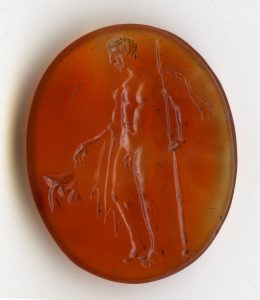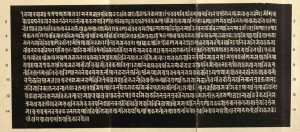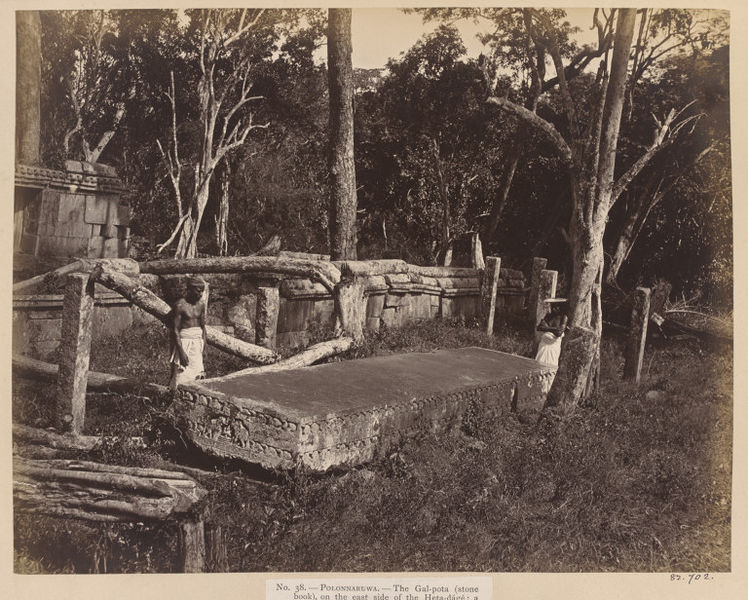OB01103 Carnelian intaglio with a standing figure

Engraved carnelian with a standing figure and inscription in one letter, British Museum 1897,0528.6.
Nalanda inscription of Vipulasrimitra

Nālandā (Bihār). Stone inscription of Vipulaśrīmitra.
Nālandā नालंदा inscription of Vipulaśrīmitra

Nālandā (Bihār). Stone inscription of Vipulaśrīmitra.
OB03072 Poḷonnaruva Slab at the North Gate of the Citadel
IN03092 Poḷonnaruva Slab Inscription at the North Gate of the Citadel
The inscription covers both sides of a stone slab, which was found completely buried at the North Gate of the ruined citadel at Poḷonnaruva. The slab was subsequently placed in an upright position near the gate. There are 37 lines inscribed on the obverse and 36 lines on the reverse. Another copy of this inscription was found on a slab of similar size and shape at the East Gate of the citadel.
The inscription begins and ends with Sanskrit verses in śārdūla-vikrīḍita metre. The rest of the text is written in Sinhalese and displays the same bombastic style as other inscriptions of king Niśśaṅka-Malla, who reigned from 1187 to 1196 A.D. The inscription gives a panegyrical account of Niśśaṅka-Malla’s virtuous qualities and charitable acts, followed by an exhortation in which he advises his subjects to choose for their sovereign a prince or princess of his own Kāliṅga dynasty. He denounces vehemently the aspiration of the Govi caste and of the non-buddhistic princes from Coḷa or from Kēraḷa to the throne of Ceylon, emphasising these sentiments with the threat that all those who join them would be treated as traitors and would accordingly by extirpated together with their families and their worldly possessions. Wickremasinghe notes that the king’s appeal to his subjects to choose a sovereign from his own dynasty is similar to that given in the Galpota inscription (IN03081).
OB03064 Poḷonnaruva Kalā-Krīḍā-Vinoda-Gal-Āsana
The Quadrangle (Dalada Maluwa), Polonnaruwa, Sri Lanka
Detail of the Kalā-Krīḍā-Vinoda-Gal-Āsana at the Quadrangle (Dalada Maluwa), Polonnaruwa, Sri Lanka
IN03084 Poḷonnaruva Kalā-Krīḍā-Vinoda-Gal-Āsana Inscription
The inscription is engraved around four sides of the smoothed upper surface of an oblong stone seat (āsana), which stands near the north-east corner of the Piḷimagē (‘image-house’) in the group of ruins on the Tōpa-väva quadrangle (the Dalada Maluwa) in Polonnaruwa. According to H. C. P. Bell, the seat was brought from the shrine of Thūpārāma, where it had been improperly utilised as a flower altar. It is therefore not clear where exactly the seat originally stood. The inscription consists of four lines, beginning with a Sanskrit stanza. It records that king Niśśaṅka-Malla sat on this seat to witness the entertainments of various artists after he had returned from his campaign in India and had completed the restoration of Buddhist monuments in Ceylon. Niśśaṅka Malla reigned from 1187 to 1196 A.D. A slab-inscription at Ruvanväli-dāgaba (IN03077) states that Niśśaṅka Malla undertook the reparation of the dāgabas in Anurādhapura in the fourth year of his reign i.e. 1191-92 A.D. As the present inscription refers to this campaign of restoration, it must date from 1191 A.D. or later.
OB03061 Poḷonnaruva Galpota (‘stone-book’)
Galpotha Inscription, Polonnaruwa.
Polonnaruwa. The Gal-pota (stone book), on the east side of the Heta-dágé; a single stone 28 feet long, 5 feet broad, and averaging 2 feet 5 inches in thickness, the upper face inscribed, and the sides and ends sculptured. Photographed by Joseph Lawton (d. 1872), active in Sri Lanka between 1866 and 1872. V&A 82702.
IN03081 Poḷonnaruva Galpota Slab Inscription
The inscription is engraved on an oblong slab, called gal-pota (‘stone-book’), which lies close to the eastern outer wall of the so-called Häṭa-dā-gē, ‘the Shrine of Sixty Relics’, at Poḷonnaruva. Consisting of seventy-two lines and more than 4,300 letters, the inscription is the longest known in Sri Lanka. It was created during the reign of Niśśanka Malla (1187-1196 A.D.) but no specific date is given in the text. The contents of the inscription record the great actions of Niśśanka Malla. Wickremasinghe interprets the text as part of an broader political strategy in which the king commissioned numerous inscriptions extolling his good deeds in a bid to present himself as a sovereign who held his authority entirely for the good of the community, thereby winning the confidence of his subjects and securing his claim to the throne. Niśśanka Malla appears to have been the first Sri Lankan monarch to employ such a strategy. The galpota inscription contains an important exposition of his political theory of kingship.
The galpota is aligned north-south and measures more than eight metres long. It was raised on a brick podium sheltered by a canopy supported on ten pillars. Both sides and ends of the slab are ornamented by double bands of haṁsas moving from left to right. At the middle of each end is a seated figure of Lakṣmī holding flowers, upon which a pair of elephants pour water from a chatty. The surface of the slab is divided into three partitions, each of which contains a portion of the inscription, starting from the first line at the top left-hand (south-west) corner of the stone slab. These partitions are designed to be read separately. The third partition is damaged, rendering some parts of the inscription illegible. A postscript on the vertical face of the southern end of the slab tells us that this stone was brought for the special purpose of engraving the present record from Sǟgiriya (Mihintale) by the mighty men of Niśśaṅka-Malla. This would imply that the slab was transported upwards of eighty miles. However, Wickremasinghe and others have suggested that the stone was in fact sourced from Sigiriya, only 15 miles distant, rather than Sǟgiriya.
OB03058 Poḷonnaruva Häṭa-dā-gē Portico Slabs
Entrance to the Hatadage, Polonnaruwa. The slab inscription can be seen on the right in this photograph.


